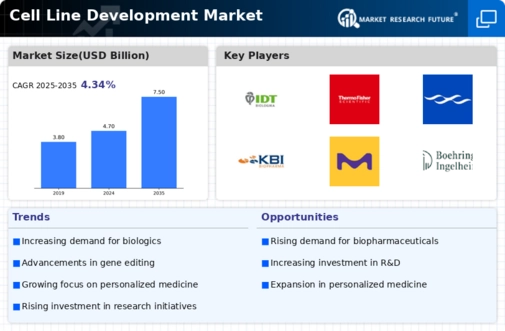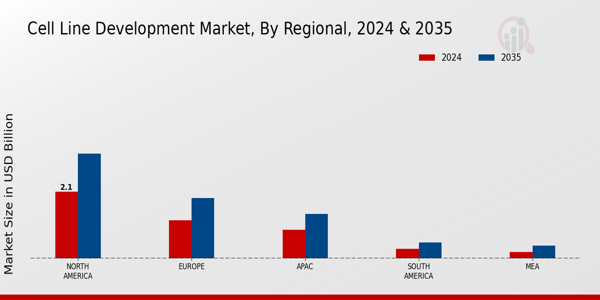Cell Line Development Size
Cell Line Development Market Growth Projections and Opportunities
The market factors influencing the cell line development market are multifaceted and dynamic, encompassing a range of economic, technological, and regulatory influences. Economic factors play a significant role, as the demand for cell lines is often tied to the overall growth and investment in biopharmaceuticals and biotechnology. As healthcare expenditures rise globally, particularly in emerging markets, the demand for cell lines used in drug discovery, vaccine development, and biomanufacturing also increases. Additionally, technological advancements drive market growth by enabling more efficient and cost-effective cell line development processes. Innovations such as automated cell culture systems, genome editing techniques like CRISPR-Cas9, and high-throughput screening methodologies enhance productivity and streamline workflows, thereby fueling market expansion.
Regulatory factors are another critical aspect shaping the cell line development market landscape. Stringent regulations governing the use of cell lines in research and biomanufacturing necessitate compliance with safety and quality standards. Regulatory agencies, such as the U.S. Food and Drug Administration (FDA) and the European Medicines Agency (EMA), mandate rigorous testing and characterization of cell lines to ensure product safety and efficacy. Adherence to these regulations not only ensures market access but also fosters trust among stakeholders, driving demand for validated and well-characterized cell lines.
Moreover, the competitive landscape profoundly influences market dynamics. The presence of established biotechnology companies, contract research organizations (CROs), and academic institutions specializing in cell line development intensifies competition. Companies vie for market share by differentiating their offerings through technological innovation, product quality, and service excellence. Strategic collaborations and partnerships between industry players, aimed at leveraging complementary expertise and resources, further shape market dynamics. Mergers and acquisitions are also common strategies employed by companies to expand their product portfolios and market reach, consolidating the competitive landscape.
Furthermore, demographic trends and disease prevalence patterns exert a significant influence on the cell line development market. The aging population, coupled with the increasing incidence of chronic and infectious diseases, drives demand for innovative therapies and vaccines. Cell lines serve as invaluable tools in drug discovery and development, facilitating the screening of potential drug candidates and accelerating the pace of new product development. Additionally, personalized medicine initiatives, which aim to tailor treatments based on individual genetic profiles, drive demand for patient-derived cell lines and specialized cell culture models.
On the supply side, factors such as raw material availability, production scalability, and manufacturing costs influence market dynamics. Cell line developers must ensure a reliable supply of high-quality cell culture media, growth factors, and other essential reagents to support consistent cell line production. Scalability is crucial to meet varying demand levels and accommodate the transition from research-scale to commercial-scale production. Moreover, cost considerations play a significant role in the adoption of cell line development technologies, particularly for small and medium-sized enterprises (SMEs) and academic researchers with limited budgets.














Leave a Comment